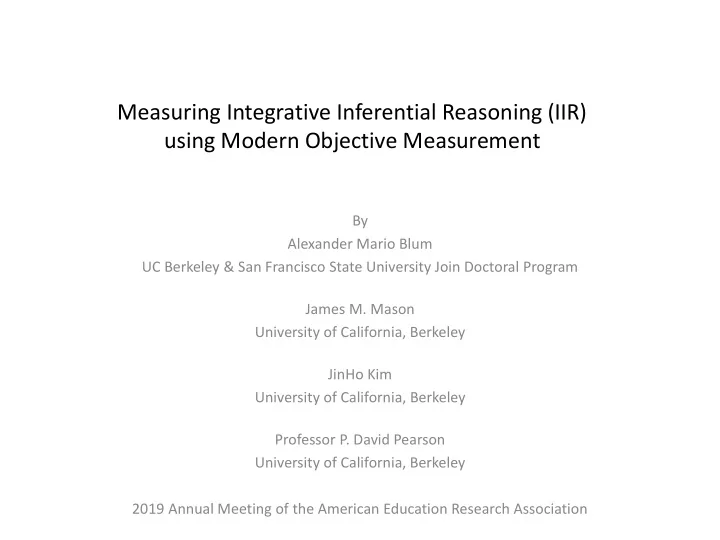

Measuring Integrative Inferential Reasoning (IIR) using Modern Objective Measurement By Alexander Mario Blum UC Berkeley & San Francisco State University Join Doctoral Program James M. Mason University of California, Berkeley JinHo Kim University of California, Berkeley Professor P. David Pearson University of California, Berkeley 2019 Annual Meeting of the American Education Research Association
Pearson & Johnson (1978) Text-Explicit Text-Implicit Script-Implicit QAR QAR QAR
Warren, Nicolas, & Trabasso (1979) Motivational Evaluative Inference Inference
Chikalanga (1992) Motivational Inference Text-Implicit Script-Implicit
Causal- Superordinate Antecedent State Goal Knowledge Based Inferences (SUBSET) Graesser, Warren, Singer, & Trabasso (1994) Character Thematic Emotional Causal- Reaction Consequence
Construction-Integration Model Kintsch (1988) Situation Model
E x p l i c i t I Theoretical Position n Degree of increasing and decreasing explicit t integration e g r a t i o n
Theoretical Position E - Degree of increasing and decreasing x integration p - Pearson & Johnson’s (1978) QAR l categories make up this continuum i c i t I n Script-Implicit QAR t e g r a Text-Implicit QAR t i o n
Theoretical Position E - Degree of increasing Script-Implicit & Text-Implicit x and decreasing QAR p integration l - Pearson & Johnson’s i (1978) QAR categories make up this continuum c - A new category is being i posited: t The Combination Category I Script-Implicit QAR n t e g r a Text-Implicit QAR t i o n
E Graesser Script-Implicit & Text-Implicit x et al., QAR (1994) p l i c i t Graesser I Script-Implicit QAR et al., n (1994) t e g r a Graesser Text-Implicit QAR t et al., i (1994) o n
Items Design Meta-Reasoning Motivational Evaluative Probe Inference Inference Probes Probes (What made you think of that answer) Outcome Space Degree of Degree of Degree of Explicit Explicit Explicit Integration Integration Integration
This gives rise to the following questions in literacy research – (a) can these theories be united to form a single construct? – (b) how many levels are there to this construct? – (c) is there a hierarchical relationship between these levels as they relate to narrative comprehension? – (d) does this construct relate to development?
Objective • The construction and validation of an instrument, through the use of appropriate measurement methodologies, that is conducive to answering these questions.
Demographics • 72 Students • Grades 3-6 • Ages 8-12 years old • General Education • Public School in the Bay Area, CA
So What Did We Find?
E x Script-Implicit & Text-Implicit p QAR l i c i t I Script-Implicit QAR n t e g r Text-Implicit QAR a t i o n
E Latent Regression x p l i c i t I n t e g r a t i o n
Multi-Dimensional Analysis
Multi-Dimensional Analysis
Multi-Dimensional Analysis .760 .767 .834
E Graesser Script-Implicit & Text-Implicit x et al., QAR (1994) p l i c i t Graesser I Script-Implicit QAR et al., n (1994) t e g r a Graesser Text-Implicit QAR t et al., i (1994) o n
Thank You! • Contact Information – Alexander Mario Blum • Alexander.M.Blum@Berkeley.edu – James M. Mason • Jmason888@Berkeley.edu – JinHo Kim • PotatoPaul@Berkeley.edu – P. David Pearson • Ppearson@berkeley.edu
Recommend
More recommend